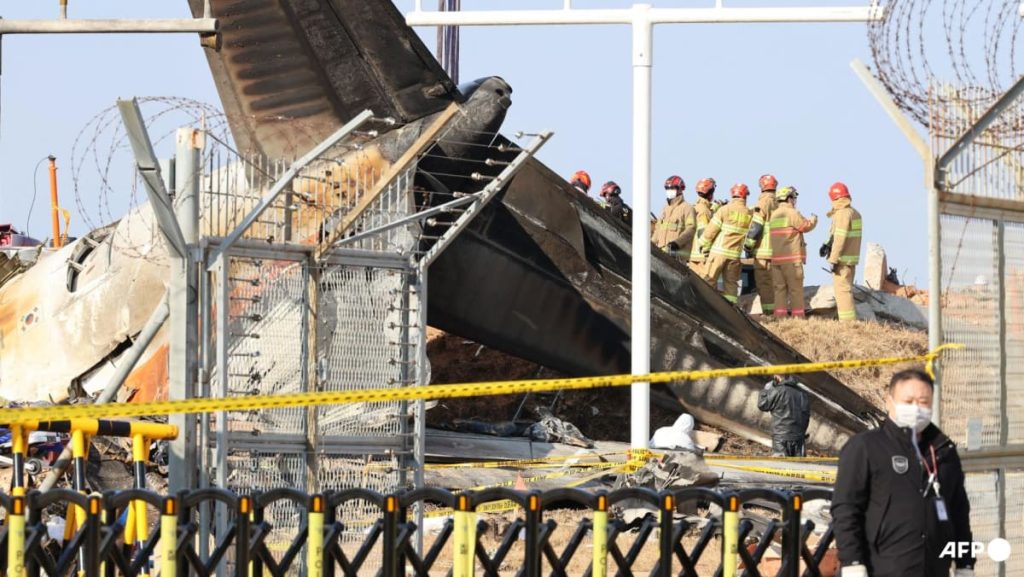The tragic crash of Asiana Airlines Flight OZ164 on December 29th, claiming the lives of 179 passengers and crew, has prompted an extensive investigation into the circumstances surrounding the catastrophe. The Boeing 737-800, en route from Bangkok to Muan International Airport, attempted an emergency belly landing after reporting a bird strike, ultimately overshooting the runway and colliding with the localizer structure. This concrete and earth embankment, housing the airport’s navigational antennae, is believed to have significantly contributed to the devastation. The South Korean investigators’ preliminary findings, recently shared with victims’ families, shed light on the harrowing final moments of the flight, including the pilots’ discussions regarding a flock of birds observed during their approach.
The report meticulously details the sequence of events leading up to the crash. While the precise timing of the bird strike remains uncertain, the pilots declared a mayday, explicitly citing the bird strike as the reason for initiating a go-around maneuver. Post-crash examination of the engines revealed unmistakable evidence of the impact, with feathers and bloodstains discovered on both. The violent collision with the embankment resulted in a fire and partial explosion, burying the engines deep within the soil mound and scattering debris from the forward fuselage across a wide radius, extending from 30 to 200 meters from the point of impact.
A critical aspect of the investigation centers around the abrupt cessation of data recording by the aircraft’s two black boxes mere moments before the mayday call. The report indicates that the recorders stopped functioning while the aircraft was at an altitude of 152 meters and a speed of 298 km/h, leaving investigators with a crucial gap in their understanding of the events immediately preceding the emergency. The reason for this simultaneous failure remains undetermined, and further analysis will be required to ascertain whether it was caused by the bird strike, subsequent damage, or some other unforeseen factor.
The report’s focus on the physical evidence collected at the crash site provides a grim picture of the destructive forces at play. The finding of bird remains on both engines confirms the pilots’ initial assessment and raises questions about the extent of damage sustained by the engines as a result of the impact. The widespread scattering of fuselage debris testifies to the violence of the collision with the localizer structure, highlighting the significant role this obstacle played in the scale of the disaster.
The investigation into this tragic accident is far from complete. While the evidence points to the bird strike and subsequent impact with the localizer structure as key contributing factors, many questions remain unanswered. The sudden failure of the flight data recorders presents a significant challenge to investigators, depriving them of vital information about the final moments of the flight. Future investigations will likely focus on retrieving and analyzing data from other sources, such as air traffic control recordings and radar data, to reconstruct the events leading up to the crash. Furthermore, a thorough examination of the aircraft’s maintenance records and the pilots’ training and experience will be crucial in determining whether any other factors, such as mechanical malfunction or human error, played a role in this devastating incident.
The Asiana Airlines Flight OZ164 crash serves as a stark reminder of the inherent risks associated with air travel. While bird strikes are relatively common occurrences, the confluence of factors in this particular instance – the bird strike, the subsequent emergency landing, the presence of the localizer structure, and the unexplained failure of the data recorders – resulted in a catastrophic outcome. The ongoing investigation will undoubtedly yield valuable insights into the causes of this tragedy, potentially leading to improvements in aviation safety protocols and technologies to mitigate the risks of similar incidents in the future. The families of the victims, and the aviation community as a whole, await the final report with a mixture of grief and anticipation, hoping for answers and a path towards preventing such devastating losses in the years to come.

